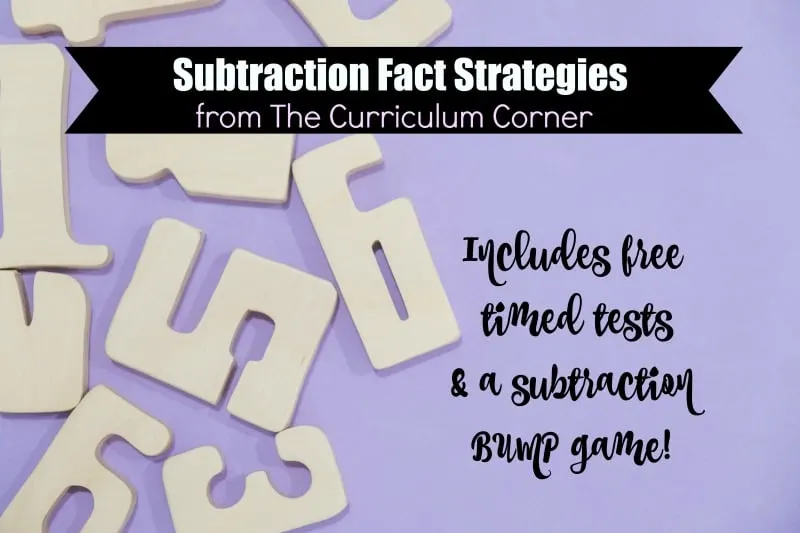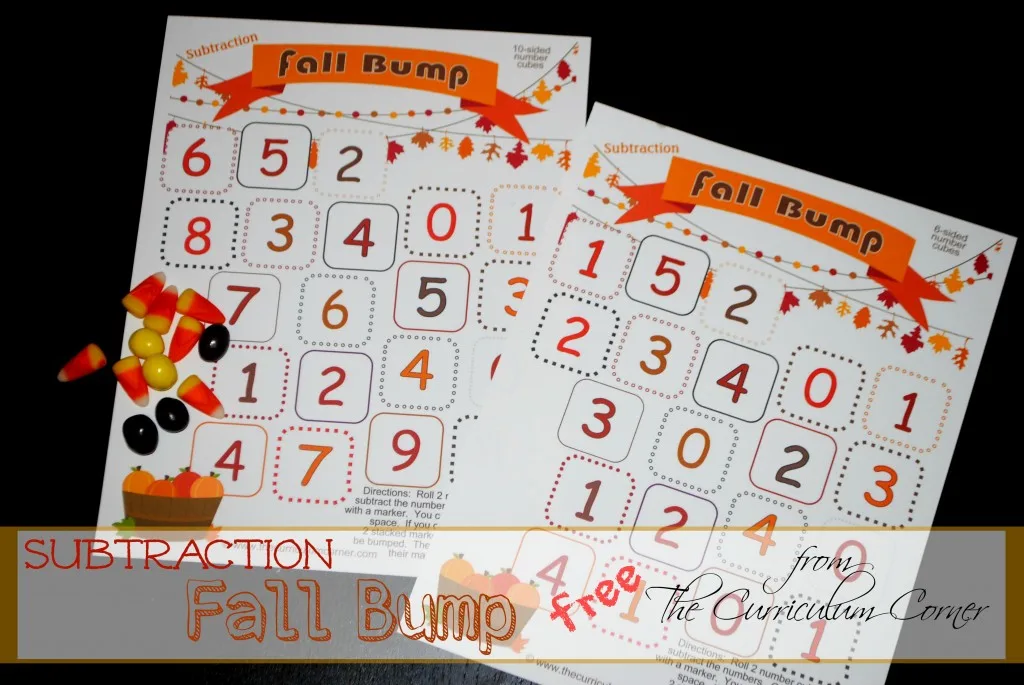These subtraction fact strategies (complete with timed tests and games) will help as you are working with your students to master their subtraction facts.

We are sharing a few of our favorite math fact strategies below. Along with the subtraction strategies, you will find a link to free timed tests along with a free BUMP game.
(Keep going to find the FREE Bump game.)
Recently we posted about how we incorporate timed math facts tests in our second grade classrooms. In that post we focused on addition facts – provided a link to our addition timed tests and included a few addition math fact practice games. You will find that post here:
Strategies to Help Students Master Addition Facts
Here we will again review how we implement timed tests (same info as before for those who looked at the addition post), but provide a link to our subtraction timed tests and include a few subtraction math fact practice games.
We realize each classroom is different and each school and district has different requirements. We understand that some teachers are required to focus on memorization of facts while others are not.
If you are required to help your students memorize facts and work on speed, these resources might be helpful for you.
This is how we incorporate subtraction timed tests into our second grade classrooms.
Students begin with 0s and progress through each level all the way through 5s. Then you can give them the mixed set of 25 problems so that they can prove they have mastered these lower levels. Once the mixed set of 25 is passed with 100% accuracy, they may then begin work on 6s -10s. Again, provide the mixed set of 25 problems for the higher levels to make sure they have mastered those.
At this point they would take the 100 mixed problem test three times (with a 95% or higher score) to prove mastery of all subtraction facts.
Also, once students have mastered addition and subtraction, they might move on to multiplication – even though mastery of multiplication doesn’t typically come fully until the 3rd grade. In our experience, parents really appreciate this because they feel their students get a “leg up” for third grade and are working at their own accelerated pace.
How Long Should My Students Be Given?
We have read that research supports allowing approximately 4 seconds per problem to prove mastery.
So, on the 25-problem tests we have created students would get 1 minute and 40 seconds to complete the test.
At “time’s up” we allow students to put pencils down and complete any unfinished problems with a crayon. This gives them a sense of completion and also allows for a bit more practice. The score would be all correct answers in pencil out of 25.
We try to give these tests three times a week if possible. Because they are so quick, it doesn’t take up much of math time.
Here is the link to the subtraction math fact timed tests and resources we have created:
Subtraction Timed Test Resources
(These timed tests have been updated with both vertical and horizontal versions of the test so that you can give your students both types.)
There is lots of debate about whether or not these types of timed tests are appropriate for all kids because they can sometimes create apprehension in students.
Here are some tips for how we help kids master math facts using these quick assessments and also to alleviate anxiety.
1. Keep it individual. Give students sticker charts to keep track of their progress and encourage them to be private about their levels. Be sure to emphasize that learning math facts is something that is mastered based on practice, but it is most certainly something in which students will progress differently. As students pass different levels let them move forward, even as others have the need to take a level again and again. One way to manage this in class is to write names on individual leveled pages before passing them out and place them face down in front of each child. This certainly won’t keep individual levels a secret, but once you start the timer, students are typically more focused on their own pages. **TIP: Don’t let students stop working if they finish early. Tell them they need to double check as many answers as they can before the time is up.**
2. Keep it motivational. Be sure to celebrate ALL successes with students when it comes to improving on or passing a level. We like to give them a one-on-one smile, compliment and pat on the back the day after a timed test. Of course we also pass out stickers for their individual charts as they pass a level as well.
3. Keep in-class practice fun. As much as possible, provide not only the time to practice in class, but make it fun by finding or making up games. There are so many ways to practice math facts that are much more fun than “kill and drill”.
Here is a game we created that might help:
Fall Bump subtracting 2 digits, using 2 6-sided number cubes
Fall Bump subtracting 2 digits, using 2 10-sided number cubes
To make it more fun for fall, have your students use two different fall candies!
More than anything, remember to keep things positive. Hold conferences with students to discuss frustrations and ideas for better progress. Teach differentiated strategies to help all kinds of learners. And, communicate progress with parents and help students set personal goals for mastery.
What are some ways you help students to master their math facts? Share them with us!

100 Subtraction Facts (Mixed Review Pages) - The Curriculum Corner 123
Tuesday 12th of February 2019
[…] look at how we created a positive environment surrounding this type of testing, check out our post: Strategies to Help Students Master Subtraction Math Facts. (That post also has some additional subtraction timed test resources you may […]
25 Subtraction Facts - Mixed Review Pages - The Curriculum Corner 123
Thursday 7th of February 2019
[…] look at how we created a positive environment surrounding this type of testing, check out our post: Strategies to Help Students Master Subtraction Math Facts. (That post also has some additional subtraction timed test resources you may […]